#hideo nakai
Explore tagged Tumblr posts
Photo

幻想博物館 中井英夫 講談社文庫 カバー・本文装画=建石修志
23 notes
·
View notes
Text
Yesterday
Part 2 of The Kuril Islands Withering
In the aftermath of the explosion, uncertainty weighs heavy, as does guilt. (Or: Hideo, Masako, and old and new friends wait to see if Seichou will be okay)
Read here
#paulowniaverse#bsd oc#seichou matsumoto#fanfic#ajax's content#ajax's fics#hideo nakai#masako togawa#mary shelley#christina rossetti
0 notes
Text










"That's how I began to hate you."
天国と地獄 (Tengoku to Jigoku / High and Low), 1963.
Dir. Akira Kurosawa | Writ. Ryūzō Kikushima, Hideo Oguni, Eijiro Hisaita & Akira Kurosawa | DOP Asakazu Nakai & Takao Saito
#天国と地獄#high and low#akira kurosawa#crime drama#thriller#police procedural#japanese film#1960s#10 frames#toshiro mifune
32 notes
·
View notes
Photo

Kyoko Kagawa and Toshiro Mifune in High and Low (Akira Kurosawa, 1963)
Cast: Toshiro Mifune, Tatsuya Nakadai, Kyoko Kagawa, Tatsuya Mihashi, Kenjiro Ishiyama, Isao Kimura, Takeshi Kato, Yutaka Sada, Tsutomu Yamazaki, Takashi Shimura. Screenplay: Hideo Oguni, Ryuzo Kikushima, Eijiro Hisaita, Akira Kurosawa. Cinematography: Asakazo Nakai, Takao Saito. Production design: Yoshiro Muraki. Music: Masaru Sato.
High and Low begins surprisingly, considering that Kurosawa is known as a master director of action, with a long static sequence that takes place in one set: the living room of the home of Kingo Gondo (Toshiro Mifune), an executive with a company called National Shoe. The sequence, almost like a filmed play, depicts Gondo's meeting with the other executives of the company, who are trying to take it over, believing that the "Old Man" who runs it is out of touch with the shoe market. Gondo, however, thinks the company should focus on well-made, stylish shoes rather than the flimsy but fashionable ones the others are promoting. After the others have gone, we see that Gondo has his own plan to take over the company with a leveraged buyout -- he has mortgaged everything he has, included the opulent modern house in which the scene takes place. But suddenly he receives word that his son has been kidnapped and the ransom will take every cent that he has. Naturally, he plans to give in to the kidnappers' demands -- until he learns that they have mistakenly kidnapped the wrong child: the son of his chauffeur, Aoki (Yutaka Sada). Should he go through with his plans to ransom the boy, even though it will wipe him out? Enter the police, under the leadership of Chief Detective Tokura (Tatsuya Nakadai), and the scene becomes a complicated moral dilemma. Thus far, Kurosawa has kept things stagey, posing the group of detectives, Gondo, his wife (Kyoko Kagawa), his secretary (Tatsuya Mihashi), and the chauffeur in various permutations and combinations on the Tohoscope widescreen. But once a decision is reached -- to pay the ransom and pursue the kidnappers -- Kurosawa breaks free from the confinement of Gondo's house and gives us a thrilling manhunt, the more thrilling because of the claustrophobic opening segment. The original title in Japanese can mean "heaven and hell" as well as "high and low," and once we move away from Gondo's living room we see that his house sits high on a hill overlooking the slums where the kidnapper (Tsutomu Yamazaki) lives, and from which he can peer into Gondo's house through binoculars. We return to the police procedural world of Stray Dog (Kurosawa, 1949), where sweaty detectives track the kidnapper through busy nightclubs and the haunts of drug addicts, and Kurosawa's cameras -- under the direction of Asakazu Nakai and Takao Saito -- give us every sordid glimpse. It's a skillful thriller, based on one of Evan Hunter's novels written under the "Ed McBain" pseudonym, done with a masterly hand. Even though it's one of Kurosawa's lesser-known films, there are those who think it's his masterpiece. In any cast it has unexpected moral depth, enhanced by fine performances, including a restrained one by Mifune -- this time, the freakout scene goes to Yamazaki as the kidnapper.
7 notes
·
View notes
Photo






Ikiru (To Live)
1952 / Japan
Director: Akira Kurosawa
Writer: Shinobu Hashimoto & Hideo Oguni
Director of Photography: Asakazu Nakai
Music: Fumio Hayasaka
Drama
4 notes
·
View notes
Photo
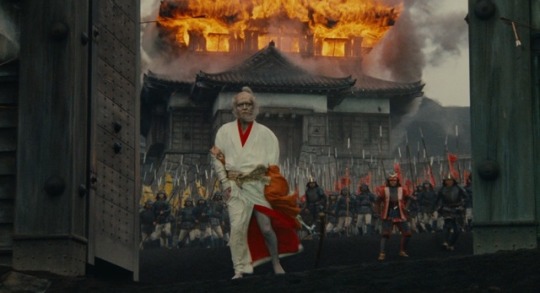

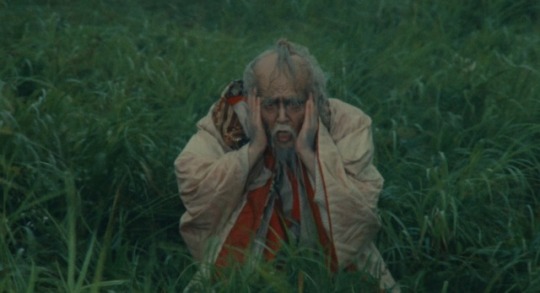
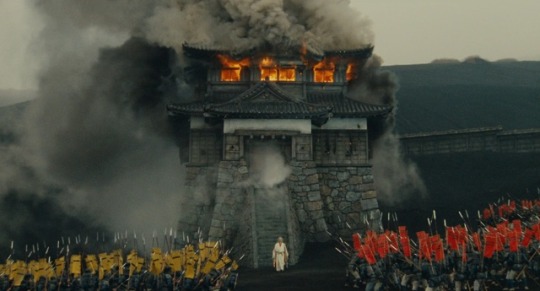


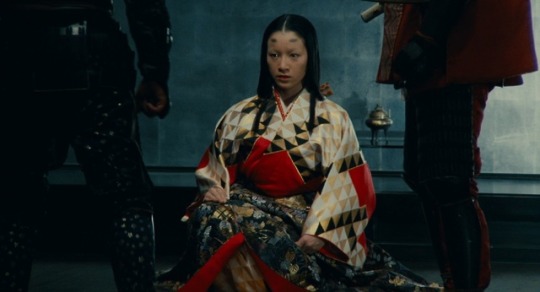
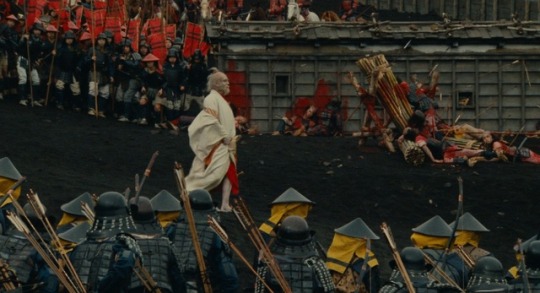
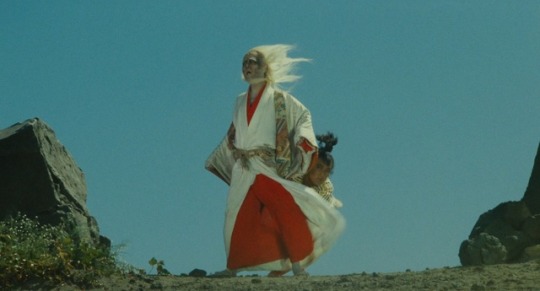
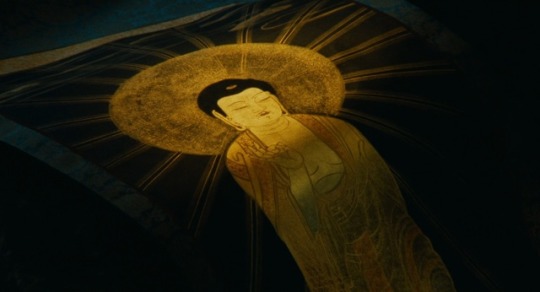
Ran (1985)
Directed by Akira Kurosawa
#akira kurosawa#hideo oguni#masato ide#tatsuya nakadai#mieko harada#乱#tōru takemitsu#asakazu nakai#takao saitō#masaharu ueda#yoshiro muraki#emi wada#cinematography#toho
4 notes
·
View notes
Text
ok so i finally have pirated tomodachi life and decided 2 make it w parasyte peeps bc why not and here r some of the deets
-> hideo keeps on tryna set up murano w shinichi [would never have thought he would even be a match maker]
-> hirokawa is friends w every teen there *except* 4 tatsuki 😭
-> reiko is the most beloved one there
-> miki n yua r married hehe :Pc
-> gotou rly likes spending his time in the beach ….
-> afryea n murano r best buddies :D [and she hit off rly well w hideo]
-> gotou and the teens r the only ppl that work 4 some reason
-> hideo n shinichi somehow get along rly well
-> so does tatsuki n reiko [like all the time - they r best friends even :0]
-> murano rly likes 2 hang out w hirokawa 4 some reason n often gets teased about it [honestly wish i knew why but]
-> shinichi is fr having the best time of his life
-> tatsuki n hideo do baseball n tennis
-> hirokawas favourite activity is either rolling on the floor or falling down 😭
-> reiko likes fishing
i kinda wanna add shinichis dad n maybe ppl like Steve-Bob n nakai but if u have suggestions then go ahead










just some of my favs
4 notes
·
View notes
Text
Jiko Bukken: Kowai Madori (JM, 2020) (Sub. Esp)

DESCARGAR O VER ONLINE AQUÍ
Título: Jiko Bukken: Kowai Madori También conocida como: Stigmatized Property País: Japón Género: Terror, drama Duración: 111 min. Fecha de estreno: 28 de agosto, 2020 Dirección: Nakata Hideo Guion: Brasilie Ann Yamada SINOPSIS Yamano Yamame es un comediante impopular. Su senpai le informa que "...se emitirá en TV, si te quedas en la propiedad estigmatizada donde tuvo lugar un asesinato". Así es como Yamano Yamame empieza a alojarse en propiedades estigmatizadas. Y en esas propiedades estigmatizadas, experimenta varios fenómenos antinaturales. CAST Kamenashi Kazuya como Yamano Yamame Nao como Kosaka Azusa Seto Koji como Nakai Taisa Kinoshita Houka como Matsuo Eguchi Noriko como Yokomizu MEGUMI como Kaori
TRÁILER: https://www.youtube.com/watch?v=85sfRzzLrn8
#jiko bukken#stigmatized properties#jmovie#kamenashi kazuya#seto koji#nao#película#proyectos terminados#sub. español
2 notes
·
View notes
Text
Konami’s wheels are turning... slowly
Lot’s of interesting news heading to our heads this Monday from what I heard from Yong Yea’s video about Konami wanting to outsource their IP’s to 3rd parties.
Obviously, Akira Yamaoka has kinda given away a strong hint that he’s working on a project with Bloober which in this case would be the long awaited SH remake or the direction they had with PT before it got cancelled. Akira Yamaoka also decided that (too late) he wanted to amend the article from his interview and release it later down the line. It’s very unusual that these news happen, but we all know Yamaoka is most famous for his music in Silent Hill.
Which brings me to a funny story about my own involvement of a Silent Hill game. I mentioned this on a podcast that I was part of 2 Konami-owned IP’s that went into another direction and killing off their franchises which have been like dead bodies in a morgue for the last 7 years.
I got the request to write industrial-metal music for a Silent Hill (of course at this time I only knew the IP and their most famous version of the game has been Silent Hill 2.) game. First I was of course very excited to be part of the series, but I jumped to early until I found out it was a Pachinko-machine (A japanese style pinball-game mixed with a touch-screen and a one-armed bandit and a slot-machine in one.), and my heart sank a little. I think I produced 4-5 cues for the machine, but I’m glad that nobody will be able to hear my ��mediocre” masterpieces because all you would hear are metal-balls falling into a tray. But the thing about this machine, it had taken cut-scenes from Silent Hill 2, upscaled or even re-mastered/remade the graphics which would have looked great if it was its own game. But it was the same thing they’ve done with all their other IPs when those transfer over to this kind of entertainment. All what was left of it, Jim Sterling turned the game into a Meme and all I can hear is the -”HIT THE LEVER!” and the effects overpowering the music behind it. But I’m glad it didn’t go further then that. Technically here, Silent Hill(s) died with the arrival of the pachinko-slot machine and the series have tried to re-establish itself ever since.
Another game I was a part of was a Castlevania (Dracula in Japan) themed Pachinko-slot machine, with the revolutionary phrase “Erotic Violence” in it’s PR material and video-commercial. I mean, they took the music production part of this machine very seriously because I wasn’t aware of the “EV” part. I just thought it would be a machine praising the history of Castlevania. I was assigned to re-write and re-orchestrate a few songs from Neo-classical Metal music into more Progressive Metal style, and I was super-proud of this one because they had the sheet-music already available for me. All I had to do was re-arrange some parts for a string-quartet (1 cello, 2 violins and 1 viola) and I believe it was engineered and recorded by famed engineer Kenji Nakai who was under and working with famed engineer Mr Bruce Swedien (Michael Jackson, Quincy Jones).
From that moment me and Mr. Nakai stroke a friendship because he has a passion for Progressive Metal and he asked me if I could send more songs his way. From this we both have been incredibly busy on both of our ends, but I hope we can be able to work on something in the future. I have a feeling that might be soon.
So a long story short, Konami spent a lot of money for recording, they approved everything and we were done. But when it turned out to be a pachinko-machine and not a world-wide videogame release, I just had to facepalm myself, asking the question why they keep doing so many poor decisions. Why leaving all those fans out in the cold and really start making Castlevania mean something. This void of “lots of fancy things, but no substance” started right here...
Konami are turning their wheels a little bit too late and too slow until now. After they got rid of Hideo Kojima (Who I believe was thinking of the international-market rather than the domestic one), Konami had only one thing on their minds: Making money quick and domestically. No more wasted time on translations, straight for the gambling crowd. No need to write interesting stories. No need to introduce kids to this adult material. They wanted to earn it back as fast as possible. But we all see their decisions put them on the map as a “black-company”, who mistreat their staff, shaming them out in the office for overstaying their lunch-breaks. Moving staff from one business to another, from a programmer to a Konami-fitness Center-staff, or as a toilet-cleaner at a Konami-owned pachinko-slot gambling hall. The management of the company has been horrendous for the full-time employee. I’m glad I was not part of these later projects and only wrote stuff for them for Pro Evolution Soccer series from 2009-2012. (My work on 2010-2012 was unfortunately un-credited work. :(
Metal Gear Solid V - The Phantom Pain In My Ass
When the playable teaser called Metal Gear Solid - Ground Zeroes, came out on the PS3 and later on the PS4, it was an introduction for the new graphics engine designed by Hideo Kojima’s team, simply called The FOX-Engine. Basically this “game” was more of a demo rather than a full-product. But it looked great and with a fantastic score by Akihiro Honda, Ludvig Forssell and Harry Gregson-Williams, it had everything going for it to become something really awesome. It became a standard approach from Hideo Kojima now to produce “Playable Teasers” to show a great concept while offering a 3-4 hour short campaign, showing off the engine’s graphical capabilities.
Still, the story was under progress and I knew early on that Hideo Kojima really didn’t want to do it after he always felt that Metal Gear Solid 4 was final. But here is the curse of the die-hard fans, and I’m sorry to say it. No matter how many Iron Man movies Marvel crams out, at the 3rd movie, I started to feel “This does not feel like Iron Man anymore”. But that’s what the fans wanted and is a standard in the movie industry. Always produce a trilogy. Indiana Jones has always been the 3 movies from 1981-1989. The 4th one doesn’t really need to be called Indiana Jones at all. It was there I felt, just like with Metal Gear Solid V, they were beating a DEAD RACE HORSE.
I can’t deny the talents on display for Metal Gear Solid - Ground Zeroes. It laid down some really cool foundations for the gameplay, but I still believe the better game-series for stealth was beaten by the likes of Splinter Cell and most recently Thief. Stealth in MGS has always felt a little bit childish and I only really enjoyed MGS 1, MGS 2, tried to play MGS 3 (still have it one my Vita!) and will try to finish it. MGS 3 has felt like the TRUE Zeroes experience, with the inception of the story and lore behind the cloning of Big Boss. MGS 4 finally brought it all to a great finale and I felt, there is NOTHING more to tell. MGS 1, 2 and 4 is the Trilogy, MGS 3 serves as the Prequel and I see nothing wrong with that.
Mission - Erase Kojima’s Legacy
The making of MGS V - The Phantom Pain is kinda true to it’s title. Can you feel the nostalgia? Or are we just imagining the sensation of a Metal Gear Solid game past it’s prime? The missing link? The missing limb? And with the worlds biggest cop-out of everything that had to do with story was completely missing.
Each mission is playing out every time the same, with an intro to a TV-show, giving away massive spoilers to who would appear in the mission, you do your thing (not so much of story, just a “go-here, do that approach, sneak back out, head to pick-up) rinse and repeat. I wonder how much of this was Kojima’s fault? I don’t think he was up to it. I’m sure he fought for more story but the big heads didn’t want to listen to what makes a MGS game a MGS game. The new management had now already played the hand to disown the man who put Konami on the map for games since the mid 80s.
The game is no longer marketed like before. The tagline “A Hideo Kojima Game” no longer exists and will never be part of Konami’s mission of erasing the person who gave them their fame and the recognition that a game carrying the name Konami was a brand of quality for any gamer out there. Me myself, personally only played PES because of the stellar animations, but its recently since 2012, I stopped playing the series. FIFA had already cheapened itself, PES likewise. Updating the graphics, but the same old animations have been recycled back to the PES3 days. Maybe there’s been an update in the collision engine, but otherwise everything stayed the same, with the huge amount of data collected from previous years of motion-capture, why do it all over when its all about the brand recognition? Saving money on processes wherever possible. Simple Math. And here it is. MGS V is not a MGS game.
We already knew it was going to be a massive budget behind the game of MGS V. But what can Konami do to save money on MGS V? They already have the Fox Engine running from Ground Zeroes. The assets for “Snake” (I’ll let you know why I put quotation-marks around it) and standard models will extend somewhat. Oh, yes, let’s save money on a character that doesn’t speak (Quiet), over-sexualize the character to start a fan-base of people who just dig character design, animated a sexy “shower” routine for the character for boys to go nuts over. What about voice? Let’s not really try to sync the voices to the mouths. Let’s have the guy from “24″ record his performances onto tape-logs. Kiefer Sutherland would have been a good “Snake”, but I understand now that you are not “SNAKE”. The game explains pretty soon at the end that you are just a Medic and all the tapes you’ve been listening to is the original Big Boss. You never where the character of Snake. Even though this all could have been handled better, Konami wanted to save money wherever possible. We also knew David Hayter was not asked or put forward to return as “The Voice of Snake”. But in this case I start to wonder myself, David Hayter might have dodged the biggest bullet in the most expensive, commercial and very controversial game of all time once Konami decided to kill everything that built up their reputation.
Even during production Kojima managed to start working on PT. The game Konami “silenced” after it was released on the PS-store. Guillermo Del Toro and his friendship with Hideo Kojima’s dream-game was put on ice. All because Kojima was about to get frozen out of the company that was according to Konami “Wasting too much bloody money”. I might get blacklisted for saying this, but once the new management started to mess with the other IPs for just domestic/gambling market, that’s where everything went sideways. Konami wasn’t treating their heritage with respect.
It took them 7 years to realize their mistake! And now, for those who wants to be part of 3rd party developers who would get a crack at a new Castlevania, a new Metal Gear Solid (remake I hope), Konami has realized that the only way they will survive (Yeah, Metal Gear Solid Survive killed them HARD) is to let other’s take over. Maybe my dream of scoring a Metal Gear Solid game would be somewhat more possible now rather than working in the confined space of limitations posed by the higher ups at Konami. Let 3rd party developers breathe life into the IPs because I know there are smarter ways to tell a story and I would gladly like to see the return of David Hayter in the seat, without having to deal with the blank-face approach that he was faced with every time he had to audition for Snake in MGS 2, 3 and 4! David Hayter is a fantastic writer, actor and voice-actor. He has the chops and I think we are all ready for either a re-make or a better follow up to MGS 2 and the time between that one and MGS 4.
#Metal Gear Solid V#the phantom pain#Konami#Hideo Kojima#Akira Yamaoka#Yong Yea#Castlevania#Pachinko#Silent Hill#PT#Ground Zeroes#harry gregson williams#ludvig forssell#3rd Party#Bloober team#remake#Metal Gear Solid Remake
4 notes
·
View notes
Text
Heya! 💗🍓🌟Sweetness*Pop🌈🍭🌸 here!
Too bad that MK never had a Japanese dub. However if somehow by fate, then imagine this giant incredible cast:
(won't be able to include all of the characters)
Yuichi Nakamura as Liu Kang
Tomokazu Sugita as Sub-Zero
Akio Otsuka as Raiden
Kazuya Nakai as Scorpion
Junichi Suwabe as Johnny Cage
Sayaka Ohara as Sonya Blade
Koji Yusa as Kano
Hiroyuki Yoshino as Reptile
Ryo Horikawa as Goro
Houchu Ohtsuka as Shang Tsung
Hiroshi Kamiya as Kung Lao
Takehito Koyasu as Jax Briggs
Kana Ueda as Kitana
Akemi Okamura as Mileena
Kappei Yamaguchi as Baraka
Shigeru Chiba as Kintaro
Sanae Kobayashi as Jade
Tomokazu Seki as Smoke
Kotaro Nakamura as Shao Kahn
Mamoru Miyano as Noob Saibot
Takahiro Sakurai as Sektor
Masakazu Morita as Cyrax
Nobutoshi Canna as Nightwolf
Kenjiro Tsuda as Stryker
Daisuke Ono as Kabal
Mayumi Tanaka as Sheeva
Kikuko Inoue as Sindel
Sho Hayami as Ermac
Jun Fukuyama as Rain
Jouji Nakata as Fujin
Chie Nakamura as Sareena
Wataru Hatano as Quan Chi
Hideyuki Hori as Shinnok
Rumi Ochiai as Tanya
Fumiko Orikasa as Li Mei
M.A.O./Mao Ichimichi as Frost
Toshiyuki Morikawa as Mavado
Hiroaki Hirata as Kenshi Takahashi
Kenta Miyake as Bo'Rai Cho
Houko Kuwashima as Ashrah
Miyuki Sawashiro as Skarlet
Asami Seto as Cassie Cage
Haruka Tomatsu as Jacqui Briggs
Kaito Ishikawa as Takeda Takahashi
Nobuhiko Okamoto as Kung Jin
Satoshi Hino as Erron Black
Aoi Yuuki/Takuya Eguchi as Ferra/Torr
Ami Koshimizu as D'Vorah
Hideo Ishikawa as Kotal Kahn
Kazuhiko Inoue as Kollector
Katsuyuki Konishi as Geras
Kotono Mitsuishi as Cetrion
Romi Park as Kronika
.....That's it!😂
I actually typed this before on YouTube hehe.😁
So MK fans, any thoughts on this Japanese dub cast especially for those who are fully aware of these seiyuus & their roles?😉🎮
12 notes
·
View notes
Photo

悪夢の骨牌 中井英夫 講談社文庫 カバー・本文装画=建石修志
19 notes
·
View notes
Photo

Horror Comes Home: Essays on Hauntings, Possessions and Other Domestic Terrors in Cinema, edited by Cynthia J Miller and A Bowdoin Van Riper, McFarland, 2019. Info: mcfarlandbooks.com.
Home, we are taught from childhood, is safe. Home is a refuge that keeps the monsters out—until it isn’t. This collection of new essays focuses on genre horror movies in which the home is central to the narrative, whether as refuge, prison, menace or supernatural battleground. The contributors explore the shifting role of the home as both a source and a mitigator of the terrors of this world, and the next. Well known films are covered—including Psycho, Get Out, Insidious: The Last Key and Winchester House—along with films produced outside the U.S. by directors such as Alejandro Amenábar (The Others), Hideo Nakata (Ringu) and Guillermo Del Toro (The Orphanage), and often overlooked classics like Alfred Hitchcock’s The Lodger.
Contents: Acknowledgments Introduction – Cynthia J. Miller and A. Bowdoin Van Riper I. Uncanny Spaces Romping with Freud in the Pink Palace: Abjection, the Uncanny and the Victorian Feminine in Henry Selick’s Coraline (2009) – Sue Matheson Guillermo del Toro’s Home for Horrified Orphans – William M. Crouch This House Is Ours: Haunting the Self in Alejandro Amenábar’s The Others – Ismael Ibáñez-Rosales and Anabel Altemir-Giral Inside the Box: Home, Horror and Helplessness in Demon Seed – A. Bowdoin Van Riper II. Dark Legacies Ghost Karma: The Winchester House as Spiritual Reparation – Thomas Robert Argiro The House That White Privilege Built: Jordan Peele’s Get Out and the Haunting Legacy of Plantation Slavery – Cammie M. Sublette Haunted Suburbs, Missing Children and the Reagan-Era Bogeyman: Stalking Gothumentary Catharsis in Cropsey – Ruth Goldberg Feminism’s Reoccurring Nightmare: Monstrous Patriarchy, Pulp Horror and The Stepford Wives – Ruth Wollersheim Fractured Heroines, Traumatic Pasts: Traversing the Haunted Homes of Horror – Nina K. Martin III. Troubled Minds and Bodies Television Killed the Video Star: How A&E’s Bates Motel Explains the Shock of Hitchcock’s Psycho as a Realist Account of Daily Life in Late Capitalism – David Anshen Home Invasions: Masculine Spaces and the Mind in Manhunter – Brian Brems Shallow Focus: Trawling the Gothic Undercurrents of Lake Mungo – Duncan Hubber The Horror of the Circus: Exhibiting Disability in Freaks (1932) and American Horror Story: Freak Show (2014) – Tatiana Prorokova IV. Insidious Threats “We never knew you lived in the block”: The White Mother and Black Male Sexual Violence in Attack the Block – Bart Bishop Coming Home to Horror in Insidious: The Last Key – Cynthia J. Miller You Saw Me, Didn’t You? The Horror of the Mediated Eye in the Occult Horror Ringu Franchise – Senjo Nakai The Stranger in the House: Interwar Crisis Comes Home in Alfred Hitchcock’s The Lodger: A Story of the London Fog (1927) – Thomas Prasch “Lamento lo que va a ocurrir aquí”: The Place(lessness) of Youth in Mexico in Carlos Enrique Taboada’s Más negro que la noche – Phillip Serrato About the Contributors Index
8 notes
·
View notes
Text
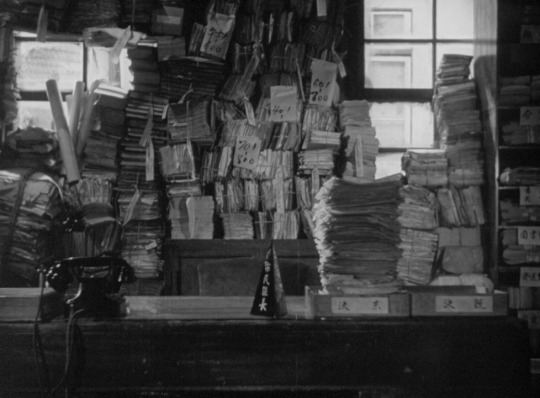

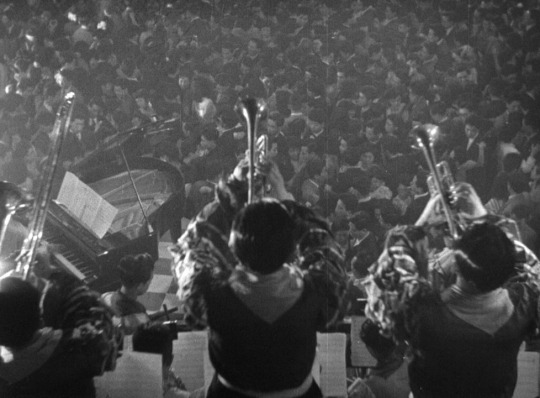
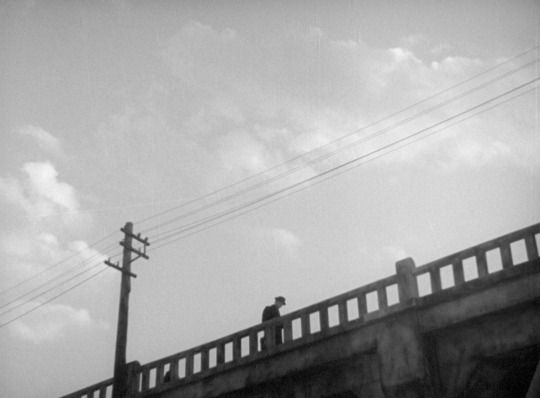


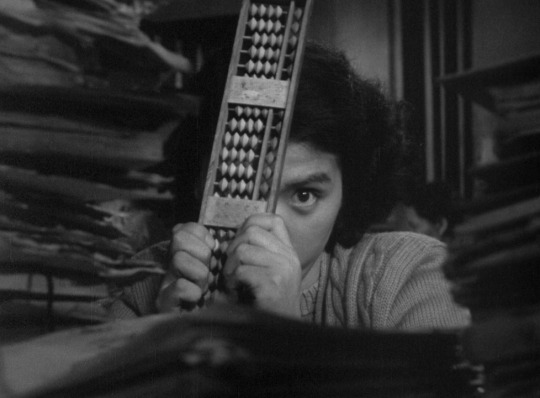

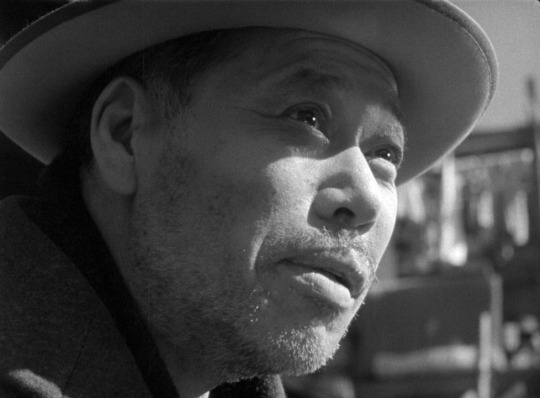

"I can't afford to hate people. I haven't got the time."
生きる(Ikiru), 1952.
Dir. Akira Kurosawa | Writ. Akira Kurosawa, Shinobu Hashimoto & Hideo Oguni | DOP Asakazu Nakai
67 notes
·
View notes
Photo
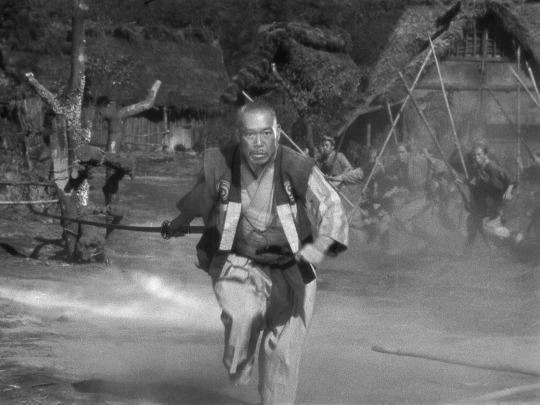
Takashi Shimura in Seven Samurai (Akira Kurosawa,1954)
Cast: Toshiro Mifune, Takashi Shimura, Yoshio Inaba, Daisuke Kato, Seigi Miyaguchi, Minoru Chiaki, Isao Kimura, Yoshio Tsuchiya, Bokuzen Hidari, Yukiko Shimazaki, Kamatari Fujiwara, Keiko Tsushima, Kokuten Kodo, Yoshio Kosugi. Shinpei Takagi, Eijiro Tono, Tatsuya Nakadai. Screenplay: Akira Kurosawa, Shinobu Hashimoto, Hideo Oguni. Cinematography: Asakazu Nakai. Production design: Takashi Matsuyama. Film editing: Akira Kurosawa. Music: Fumio Hayasaka.
It's a truism that silent movies and talkies constitute two distinct artistic media, and to judge the one by the standards of the other is an error. But it's almost impossible to watch films made by older directors, especially those who came of age when silent films were being made, without noticing the efforts they make to tell their stories without speech. It's true of John Ford, Alfred Hitchcock, and Howard Hawks, even though they, especially Hawks, became masters of dialogue in their films. And it's true of Kurosawa, who although he didn't begin his career in films until 1936 and directed his first one in 1943, was born in 1910 and grew up with silent movies. I think it helped him learn the universals of storytelling that are independent of language, so that he became the most popular of all Japanese filmmakers. Others rank the work of Ozu or Mizoguchi more highly, but Kurosawa's films manage to transcend the limitations of subtitles more easily. Of none of his films is this more true than Seven Samurai, which is also generally regarded, even by those with reservations about Kurosawa's work, as his masterpiece. That's not a word I use lightly, but having sat enthralled through the uncut version, three hours and 27 minutes long, last night, I'm willing to endorse it. It's an exhilarating film, with none of the longueurs that epics -- I'm thinking of Gone With the Wind (Victor Fleming, 1939) and Lawrence of Arabia (David Lean, 1962) -- so easily fall into. I don't know of any action film with as many vividly drawn characters, and that's largely because Kurosawa takes the time to delineate each one. It's also a film about its milieu, 16th-century Japan, although as its American imitation, The Magnificent Seven (John Sturges, 1960), shows, there's a universality about the antagonism between fighters and farmers. Kurosawa captures this particularly well in the character of Kikuchiyo (Toshiro Mifune), the would-be samurai who reveals in mid-film that he was raised as a farmer and carried both a kind of self-hate for his class along with a hatred for the arrogant treatment of farmers by samurai. Mifune's show-off performance is terrific, but the film really belongs to Takashi Shimura, who radiates stillness and wisdom as Kambei Shimada, the leader of the seven. There are clichés to be found, such as the fated romance of the young samurai trainee Katsushiro (Isao Kimura) and the farmer's daughter Shino (Keiko Tsushima), but like the best clichés, they ring true. Seven Samurai earned two Oscar nominations, for Takashi Matsuyama's art direction and Kohei Ezaki's costumes, but won neither. Overlooking Kurosawa's direction, Shimura's performance, and Asakazu Nakai's cinematography is unforgivable, if exactly what one expects from the Academy.
4 notes
·
View notes
Text
Joker recaps [2/3]
[tw: obvious-murder-case-related-deaths, suicide, the post-mortem trans reveal trope]
----
The investigation team at Geneijo learns that the case has been marked as an L Crime (L from “large, lock, labirynth”), meaning the government forbid the media from talking about it as to not alarm the public. A new officer is appointed to lead the investigation in place of Ryousho: Ayukawa Tetsuko, a pleasant soul whose younger sister aims to become a JDC detective. [You may remember her from Cosmic.]
Grieving Tae wanders around Geneijo and finds Megumi in the (already cleaned up) room with the paintings. The girl seems to be afraid of Schattenburg, claiming that it portrays a monster or a ghost.
The detectives talk with Dakushoin about his writing. Dakushoin says that the phrase “for the grand downfall” that the Artist uses may be taken from Ayatsuji Yukito’s The Labirynth House Murders, but it’s safe to assume that all the writers and most of the staff of Geneijo would be familiar with it. While Souya makes copies of Dakushoin’s manuscript for everyone, Ryuuguu and Dakushoin strike a conversation and discover they understand each other well on a personal level, have similar feelings of being somewhat detached from other people, and both love playing with words a little too much.
Meanwhile, Nijikawa and Miyama have a conversation about mystery novels in a room apparently based on a location from Nakai Hideo's book An Offering to Nothingness.
--
Later Kirigirisu takes a quiet moment alone thinking deeply about the case. His subconscious keeps pushing the name of Hirai Genji at him, probably because of what Teru told him about her past.
Many years ago, before she changed her first name to Teru and was still known as Hatsune, she was involved in a love triangle with both Hirai brothers. Eventually Teru and Genji eloped, but after some events between the two Teru went back to Geneijo alone and was took in by Hirai Tarou as an employee. Even then Teru was still boy-crazy, which once resulted in her having a child with a male staff member and giving the baby away.
Teru is afraid that her lifestyle may have caused Genji to feel jealous, come back and start killing people.
--
Kirika and Nemu once more attempt to dismantle the Room of Judgment’s locked room trick. Nemu’s fuzzy reasoning tells her that the Geneijo case may be unsolvable just like the Saimon Family Case was. While the two are talking, Nemu makes a random remark that makes Kirika notice that the old boards of the Room are held together with new shiny nails, and finally realize what the locked room trick was.
As everyone sits down to dinner, Kirika says the very simple explanation: the murderer simply removed a few boards from the wall, committed murder, left the room and nailed the boards back in place. The cats were probably killed just so they wouldn’t get in the way.
As for the other crime scenes, Kirika thinks the Artist is right-handed, since both Ichirous were found with their guns in their right hands while being left-handed. At this point Ryuuguu loudly bangs his fist against the table, stands up and says that this is probably a misdirection, since the Artist would notice which hand each policeman used to hold a flashlight in the darkness of the night.
It seems like the two detectives are vigorously arguing gainst each other, but in reality they’re just acting while Nemu carefully watches if someone in the room looks anxious or relieved at the statements about the killer’s dominant hand. No one’s behaviour really stands out.
As the dinner ends, Aoi persuades the police to let him join the patrol that night, so that either he’s successful at catching the Artist, or in the worst case ends up as the victim instead of his friends.
--
Nemu can’t sleep that night and thinks about the case and her brother Juku. Nemu was too small during the Saimon Family Case to really remember much of it, and both Juku and Ajiro only gave vague answers whenever she asked them about it. If Geneijo case was just as unsolvable, would Juku still be able to resolve it? Juku’s working on a case in LA, but promised that he’d be back for his 20th birthday on 31st October, and he always keeps his word. Just two days more.
Miyama also can’t sleep, thinking about faith (“you could say that Miyama Kaoru was the sole member of Miyamakaoruism”, but Christianity is pretty close), and who on earth may be the ‘God’ of this case.
--
After 5 am Ryuuguu is woken up by the news that there was probably another murder, this time committed in the Locked Room, a perfectly isolated space with only one door. But nobody actually opened the door to check yet, since the newest note said:
This door must not be opened.
-- The Artist
Ryuuguu doesn’t listen and opens the door, causing a huge amount of water to rush out of the room and completely drench everyone standing too close. Inside the room is Aoi’s body hanging by the belt from the ceiling.
It’s also discovered that one of the mirrors in a Room of Reflections (a round room with the wall covered in mirrors and a few sculptures in the middle) had been ripped out of its place and discarded next to it.
Everyone feels down after Aoi’s death, especially Dakushoin and Tae. Nijikawa entrusts his daughter to Miyama and focuses completely on trying to solve the case.
Dakushoin talks with Ryuuguu about the case. Ryuuguu thinks that the Artist hid behind the ripped off mirror, waited until Aoi passed him, and attacked from behind. Since Aoi was the eighth victim (not counting the cats), everyone hopes the murders will end here.
--
Later that day Nijikawa knocks on Ryuuguu’s door and says he knows who the Artist is. They go together to the dining hall so that Nijikawa can announce what he found out.
According to Nijikawa, the cats and the Ichirous are just additional deaths that don’t factor into the symbolism intended by the Artist. Each of the murdered writers and inspector Ryousho died in ways referencing the deaths in Oguri Mushitaro’s famous work The Murders of Black Death Manor. The name of the eponymous manor in Japanese is kosukikan, and the bloody dakuten would change one of these syllables to achieve the word kosugikan. Like Kosugi Kan, Geneijo’s butler! But Nijikawa realizes this can be yet another misdirection.
Instead he points to the actual culprit. At first everyone thinks he’s pointing to Employee D, whose real name is Kanai Hidetaka [Seiryoin’s real name], but he actually means the cook Nasuki. Kosukikan can also be an anagram of Nasuki kok (kok meaning a cook in some languages)!
But before poor Nasuki can be arrested, Ryuuguu says that it’s too early to consider the case closed. The deaths differ too much from the ones in The Murders of Black Death Manor, the anagrams seem suspiciously perfect, and the solution doesn’t explain the need for the murders to occur in certain rooms, why the mandarin orange was really needed and so forth (and just like Ryuuguu says… In the Geneijo murder case every single thing has meaning, and not a single thing is useless.)
Ryuuguu notices even more wordplays, like another reading of the title of the book pointing to yet another random police officer, or the name of the author pointing to Kirigirisu (since kirigirisu means “a cricket”, which is a bug, mushi, and the author’s name is Mushitaro). Among all that misdirection it’s hard to tell if something’s actually the Artist’s signature.
--
The next day (30th October) everyone is in a good mood, as the case is unlikely to continue after eight murders. After lunch everyone gathers for a tea party. They have a good time talking and laughing.
Until Souya and Kirigirisu convulse and fall to the ground, dying from poison before anyone is able to help them.
--
At JDC, Ajiro Souji gets a call from Tsukumo Juku, who’s just solved the case in LA and is ready to come back and temporarily take over Ajiro’s duties, so that Ajiro will be able to personally assist the Geneijo case. Juku says that he fully believes in Nemu’s feeling about the case being unsolvable, but there is still a way to settle it. And like he always says, There’s no such thing as a mystery, there is only a logical solution.
Ajiro feels happy at the thought of going to Geneijo and working alongside his son, until a grim call from Kirika informs him that Souya is dead.
--
Ryuuguu looks more down than ever, yells that he should have been able to see this coming and accuses himself of not saving the two detectives. He claims he had a thought before the murders that sugar could be used to accuse yet another police officer, Sado Kutou (an anagram of this name being satou, sugar + doku, poison). He frantically tries to explain how and when the sugar was poisoned, but the forensics quickly say that the poison was in fact a liquid digitoxin, and that Ryuuguu himself used the sugar for his drink. Ryuuguu is so shaken by the deaths that he’s starting to miss the obvious counterpoints in favor of detailed wordplays.
The poison had to be applied to the interior of only two out of seventeen cups. It was hard to tell how the Artist knew who would get which cup, or if he even cared.
--
While the victims are all adults, little Megumi and Shouri aren’t unaffected. Shouri was mostly curious and fascinated at first, but now some of Megumi’s fear jumped on him too. He only feels at ease when he’s playing with her. Training his baseball pitching skills with Miyama is calming too, but he can’t help but feel a little uneasy around adults.
--
As was mentioned, Nijikawa entrusted Megumi to Miyama, who during the dinner had a police officer guard the door of Nijikawa’s room so that the girl would be safe. When Miyama and Shouri return to the room, Shouri knocks on the door and finds that Megumi doesn’t answer. A few minutes later alerted Nijikawa rushes to open the door with his own key.
Megumi’s body lies near a bookcase, a bloody flower pot next to her head. It seems she was hit both on the front and back of her head. The only window is closed, the door was constantly guarded. Next to Megumi’s right hand is a message written in blood:
VI
Her left wrist is sprained. [The autopsy note later says she’s left-handed.]
The desk still has her kanji exercise book open, and next to it is one of Nijikawa’s novels, A normal man who killed the goddess of victory.
The detectives ponder over the situation. The likely solutions are that either the police officer guarding the room is lying, or that the murderer got in through an open window, mortally wounded Megumi and fled, and the girl managed to close the window after him fearing his return. Ryuuguu isn’t sure what the VI means. It may be a Roman number (V and VI would be misdirections pointing to Dakushoin’s and Tae’s room numbers), or maybe German-knowing Megumi was trying to write VATER (pointing to Nijikawa), VIOLA (since Sumire, “a violet”, is what she affectionately called Miyama), or the English word VICTORY (the literal meaning of Shouri’s name, and the book on the desk mentions it too). But maybe a little girl would write the name of a loved person instead, trying to summon their help.
--
After thinking a lot in his room, Ryuuguu secretly asks the police officers to guard Nijikawa’s room from both the hallway and the courtyard sides, as he believes Nijikawa Ryou is the Artist. He doesn’t explain his reasoning just yet.
The detectives and the police spend the night observing the room, but nothing happens. The only event worth mentioning is a moderately strong earthquake at around 3 am that briefly shakes the entire Geneijo.
When they check the room in the morning, Nijikawa is dead. He’s still in his chair, blood still flowing from his left wrist, his right hand still holding a razor. [Nijikawa is left-handed.]
--
Then they find Miyama hanged in the room based on the one from An Offering to Nothingness. On the indigo carpet there’s a single chair lying on its side. In Miyama’s pocket they find a piece of paper with a simple message:
Boku wa mou TAErarenai [transl. I cannot TAkE this anymore]
--
Then they find Dakushoin impaled through the chest on one of the statues in the mirror room, that of a demon holding two amethysts. The floor is covered in water with two plain towels lying in it.
--
A few other things are discovered soon afterwards.
Aside from the manuscript that would never be finished, Dakushoin left in his room a piece of paper with 99 different numbers arranged in 9 columns. The number 99 (九十九) may be yet another misdirection pointing to Tsukumo (九十九) Nemu.
The order of deaths is confirmed to be Miyama first at around 3 am, then Dakushoin at around 4 am, then Nijikawa at around 5 am.
Everyone only now learns that Miyama wasn’t a man, but a trans woman who underwent surgery a few years ago, but still kept her true self hidden from others at Geneijo. The “gender trick” in Dakushoin’s manuscript was never a trick.
--
--
Tsukumo Juku was born on 31st October 1973, the date symbolizing his mental prowess (since “Showa 48, October 31” = 4 8 10 3 1 = yo ha ten sa i = 余は天才 = "I'm a genius"). If you added 10 months and 10 days to that date, you’d get 9th August 1974, the day when JDC was created.
“Juuku” was a portmanteu that his father Ryuusui [not to confuse with Dakushoin] made out of the names of the baby’s mother Miku and grandfather Juuzou. Keeping in with the idea that one's name should describe them, Juku from then on walked a path of life continuously filled with juuku (重苦 = intense suffering). But even during the Saimon Family Case that made adults tremble in fear and run away, Juku calmly fought against his fate.
That tragic case awoke Juku’s Jintsuuriki, a method of so-called meta-reasoning that few could access. If we define the murderer as ‘a writer’, then Juku could aquire knowledge about what ‘the intention of the writer’ was, and arrive at a solution unreachable with normal means.
Because of his abilities, having Juku – say – play a major role in a mystery novel would be extremely hard to pull off. In fact, if he was allowed to appear from the very beginning, the novel would consist of just one page (one sentence?) of Juku announcing the murderer’s name.
Unless, of course, it was a case as unsolvable as the Saimon Family Case.
Juku meets with Ajiro and asks to be allowed to go to Geneijo in Ajiro’s place.
>>>NEXT>>>
4 notes
·
View notes
Text
Seiyuu Challenge #28
28. Best seiyuu match-ups, romance edition?
If you want to find out which seiyuu are married, check out this link. It’s an updated list of marriages (and divorces).
Kenichi Suzumura x Maaya Sakamoto
Related Post (Seriously, those right there are romance goals.)
If they produce a kid, it will most likely be a god-tier too-OP kind of kid who’s good-looking, can sing and act, and is probably really smart.

Wataru Hatano x Mai Hashimoto
“[On multiple radio and TV shows] Hatano mentioned that he was fairly unlucky when it came to romance. He was cheated on multiple times, slapped on his face by women that misunderstood his intentions (he went out with them as friends and apparently they thought the opposite), was dumped “close to 10 times” in his life, one of those on a late night call that made him go to a recording – in the following day – with his eyes still swollen from crying his heart out. Due to his busy career and, even before being a seiyuu, busy life, Hatano found himself multiple times rescheduling dates or even going as far as sending gifts to his girlfriends by mail because he couldn’t meet them due to a recording (he mentioned this on Sakurai Takahiro’s Kako Warai).
Things changed and Hatano got married in 2018 with fellow female seiyuu Mai Hashimoto, finally finding happiness and putting an end to his unlucky streak.”
[Source: Seiyuu Digest #43]
Come on. He deserves it. The guy deserves it after all he’s been through.

Tsubasa Yonaga x Yuka Nishigaki
Congrats on the kid!

Tachibana Shinnosuke x Ao Takahashi
Congrats on the kid!
[Picture of the kid can be found on Takahashi’s blog]

Takuma Terashima x Satomi Sato
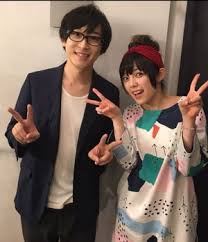
Even though I’m not the biggest fan of Terashima, he’s made Satomi happy for the eight years they dated and years that they’ve been married.
Honourable Seiyuu x Seiyuu Marriages Mentions:
Yoji Ueda x Yuko Nagashima They have a daughter
Ryota Takeuchi x Ai Terashima
Mitsuo Iwata x Rikako Aikawa (1992)
Kenji Nojima x Chie Sawaguchi They have two kids: one boy and one girl.
Other Married Seiyuu Worth Mentioning:
This just means that they married someone outside of the industry.
Format: - [NAME] (Year of marriage) Comments/Mention of kids
Chinatsu Akasaki (2018)
Kana Asumi (2014)
Aya Endou (2013)
Natsuki Hanae (2016) This one surprises me
Megumi Hayashibara (1998) She has a daughter
Yoko Hikasa (2015) Ai Kayano said, “She gets really flustered whenever the topic of marriage comes up. She seems to be very happy.” (or it was implied)
Aya Hisakawa (1999)
Mariya Isa (2015) AND SHE HAS A KID? I NEVER KNEW!
Hideo Ishikawa (1999) Itachi Uchiha might be forever alone, but at least we know his seiyuu isn’t.
Kentarou Itou And he has (a) child(ren)
Shizuka Itou (2012) I didn’t know she was married.
Yuuko Kaida
Yuu Kobayashi (2017)
Takehito Koyasu He also has kids. [insert Dio joke]
Kujira (2011)
Masaya Matsukaze (2004)
Hikaru Midorikawa (2000) He got into a huge scandal fiasco because some numnut started a rumour that he was cheating on his wife because he was wearing matching jewellery to some fan. Seriously, stay in your own lane. The guy did nothing wrong.
Shinichiro Miki He has a son.
Kotono Mitsuishi (2000) She has a daughter.
Showtaro Morikubo (2014 - 2nd marriage) He has a child from his second marriage.
Kazuya Nakai
Daisuke Namikawa (2001) But he (allegedly) cheated on her starting in 2004 which continued for many years until coming to the surface in 2017. He has two kids.
Nanri Yuuka
Kaori Nazuka (2011) She has a daughter.
Mamiko Noto (2018) She has a kid on the way!
Megumi Ogata (2004 - 2nd marriage)
Yuuki Ono (2010) In 2017, he revealed that he got married seven years prior.
Akio Otsuka (2017)
Chiwa Saito (2013) She has a daughter.
Daisuke Sakaguchi
Yuko Sanpei (2013) She has a child.
Miyuki Sawashiro (2014) SHE HAD A KID, AND I AM SO HAPPY FOR HER.
Haruka Tomatsu (2019) She just got married on the 11th. And at the time of writing this, that is pretty much a week. Happy one-week anniversary to her and her husband.
Toshiyuki Toyonaga (2015) He has a daughter.
Aki Toyosaki (2017)
Norio Wakamoto
Sayuri Yahagi (2015) Way to ruin Ayane’s dreams
Kappei Yamaguchi He has two children
#30 question seiyuu challenge#maaya sakamoto#kenichi suzumura#satomi sato#takuma terashima#shinnosuke tachibana#wataru hatano#mai hashimoto#yuka nishigaki#tsubasa yonaga#ao takahashi
6 notes
·
View notes